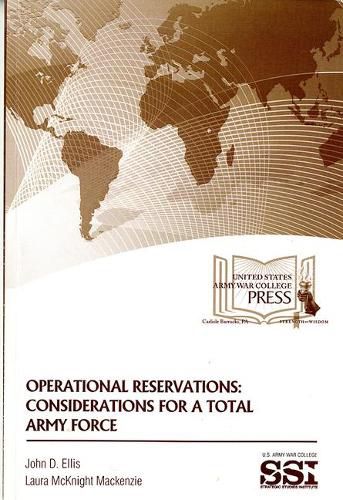This text opens with a narrative exchange between an Army General and the Active Component (AC) and Reserve Component leaders to showcase the disconnect between what Operational Reserve forces can and cannot accomplish and how they can be used by Active Component forces. The monograph looks in-depth at the requirements of both the DoD’s directive to manage the Reserve Component as an operational force and the Army’s Total Force Policy (ATFP). A number of potential problems with ATFP are examined, and suggestions made to mitigate those problems. An examination of the Army’s Force Generation (ARFORGEN) model is also included, with recommendations on how to make the model more useful for planning Reserve Component operations and training. Finally, the authors examine the almighty budget issue and its implications for the future of the Reserve Component. Throughout the monograph there is a discussion of the various mindsets and organizational cultures that permeate the AC, Army National Guard (ARNG), and Army Reserve (USAR). These mindsets and cultures have a tremendous impact on the components’ ability to interact, and will play a pivotal role in determining the success of the Army’s Total Force efforts. As the Army Reserve Components–the Army Reserve and the Army National Guard–assume an operational mission as the force drawdowns in overseas contingency operations occur, the Army senior military and civilian leadership should consider the ramifications and realities of such a mission in what is expected to be a relatively peaceful time. This monograph explores some of these considerations regarding the implementation of the Army Total Force Policy, identifies potential obstacles, and makes recommendations to better engage the three Armies in a successful and meaningful reform effort. Throughout, the authors call for significant cultural shifts in thinking about how the Reserve Components are used and integrated into a Total Force. An Appendix is included as part of this text to integrate the experiences of a Reserve Component Unit assigned to an Army Service Component Command in the form of case studies. This monograph is meant to inspire both senior and junior leaders to recognize the necessity of a cultural shift commencing in the near future. Additionally, U.S. Army reserve members, Veterans of the U.S. Army Reserve, and senior Department of Defense and military leaders may be interested in this history relating to the shift from the strategic to the Operational Reserve (OR). Related items: The Effective Use of Reserve Personnel in the U.S. Military: Lessons from the United Kingdom Reserve Model can be found here: https: //bookstore.gpo.gov/products/sku/008-000-01100-1 Warrior Citizen: The Official Magazine of the U.S. Army Reserve print quarterly periodical subscription can be found here: https: //bookstore.gpo.gov/products/sku/708-079-00000-6?ctid= The 108th Training Command: A History Embracing Innovation & Shaping the Future, 1946-2010 is available here: https: //bookstore.gpo.gov/products/sku/008-020-01597-1 Starting Strong: Talent-Based Branching of Newly Commissioned U.S. Army Officers is available here: https: //bookstore.gpo.gov/search/apachesolr_search/Army%20Reserve?page=1https: //bookstore.gpo.gov/search/apachesolr_search/Army%20Reserve?page=1
Read More





